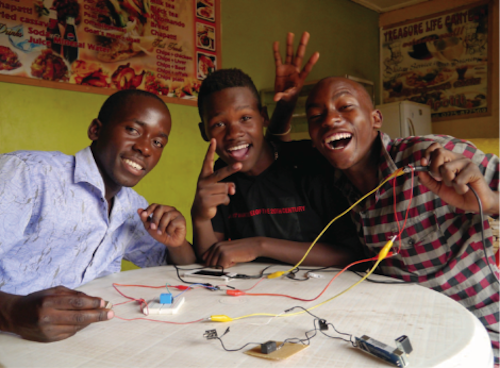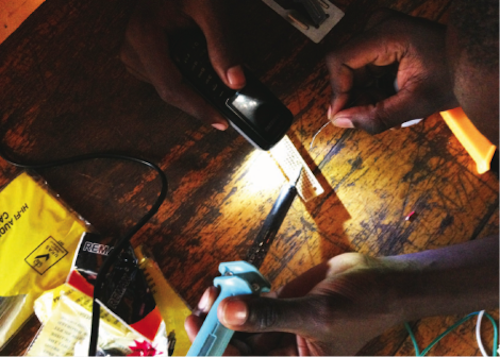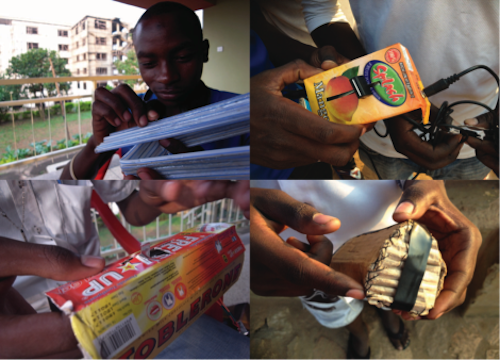
Peer-to-Peer Mentoring: VJs Shafic, Venas, and Bashir learn basic circuitry in a workshop facilitated by a peer mentor. Photo credit: Tina L. Zeng / 2014.
The following story, by Media Design Practices post-grad fellow, Tina L. Zeng, was originally published on UNICEF’S Stories of Innovation blog. The inspiring innovations reflected below are the result of the independent graduate work she began conducting in Kampala, Uganda in September 2013, supported by the UNICEF Innovation Lab.
What if technology was made to break?
What?
I recently wrote a post about a project that disrupts the current product-oriented mentality for designing technology for development. This project, weDub, is a set of platforms for youths in a slum area named Kamwokya in Kampala, Uganda to make, instead of consume, technology. weDub is a locally developed audio mixer and preamplifier that youths make to perform live improvisations of media content they reinterpret to an audience; this is locally known as VJing. I talk about the three key outcomes of the project here.

Making the weDub Circuit: Pius uses his phone’s flashlight to help Bashir while he solders wire at TLC Youth Center in Kamwokya. Photo credit: Tina L. Zeng / 2014.
This post, however, focuses on the design values that led me to design the various platforms in the project while a graduate student at Art Center Media Design Practice’s Field program.
weDub is made to break. It is made to be reinvented, remade, and repaired. Because of its perishable nature, it compels the maker to constantly innovate and learn by doing.
By designing weDub with the necessity for constant regeneration, the project then relies heavily on its community members to develop shared, and even specialized, knowledge. The project presents four platforms, or opportunities, for youth to:
- Learn basic electronics through making and manipulating technology
- Perform, rather than consume, knowledge through live performances of media analysis
- Engage in peer-to-peer mentoring by facilitating their own technology workshops
- Build a network of community contacts for support

Upcycling Perishables: Bashir, Pius, and Venas venture out into their community to find materials to encase their weDub circuit. Photo credit: Tina L. Zeng / 2014.
These platforms are developed from designing from a position of abundance— or discovering points of potential that inherently exist in the community, and then amplifying them into opportunities that can further generate other systems for growth.
What weDub values is a hands-on approach towards sourcing local electronic components to configure technology to serve a common community interest. The youths build the circuit themselves, but they also build out nodes of knowledge-building practices such as facilitating their own technology workshop and collaborating on VJing styles to enhance their engagement with the audience.
The onus, then, is on the youths to identify and reconfigure technology, thereby creating a dynamic where they are in control of manipulating materials for their purposes. Since the youths have a stake in the design and making process, they are invested in creating a sustainable network that scaffolds their efforts.
Rather than a single user using a single product in a single scenario, weDub is a communal collaboration. In this sense, technology is merely a conduit for the youths to collectively express their expertise in a multitude of mediums: speech, performance, making, and teaching.
By tapping into existing resources and youth talent in the community, design can carve out spaces for projects involving technology to cultivate of knowledge-building practices for development.








